There’s something inherently magical about a steaming bowl of Vegan Split Pea Soup with Barley and Butternut Squash on a chilly evening. This plant-based soup recipe has become my go-to comfort meal, blending the hearty essence of split peas and barley with the sweet, tender notes of butternut squash. The result? A wholesome, filling dish that not only satisfies hunger but also warms the soul.
As someone who is committed to a health-focused diet, I cherish recipes like this that pack high protein and fiber without compromising on flavor. Each spoonful feels like a warm hug, reminding me of cozy family dinners and the joy of sharing nourishing food. Whether you’re looking for hearty vegan meals or simply trying to incorporate more plant-based options into your life, this recipe promises to be a delightful addition to your culinary repertoire.
Stay with me as I share not just the recipe, but also my personal tips and tricks to perfecting this comforting soup. From the ideal cooking times to the best methods for enhancing creaminess without dairy, I’ve got you covered. Let’s dive into the delicious world of plant-based comfort food together!
Introduction to Vegan Split Pea Soup
When it comes to comfort food, vegan split pea soup stands out as a perfect blend of ease and nutrition. It’s a cherished recipe in my kitchen, especially because it’s not just delicious, but also offers numerous health benefits. Let me guide you through why this soup recipe has a special place in my heart.
Why I Love This Recipe
One reason I’m such a fan of this vegan split pea soup is its simplicity. With a few basic ingredients like split peas, barley, and butternut squash, you can whip up a hearty meal in about 30 minutes. Its creamy consistency is achieved without any dairy, making it a delightful option for vegans and those with dietary restrictions. The flexibility of this recipe allows for customizations, such as adding your favorite vegetables or spices to suit your taste.
Health Benefits of Split Peas
The health benefits of split peas make this easy vegan soup even more appealing. Split peas are a fantastic source of plant-based protein, with each serving containing 10g of protein, contributing to 20% of the daily recommended intake. Their high fiber content, 5g per serving, helps with digestion and keeps you feeling full longer. Additionally, split peas are low in fat, yet rich in essential nutrients like potassium, iron, and Vitamin A.
From the nutritional standpoint, this soup is a powerhouse. Each serving provides 108kcal, with 15g of carbohydrates (5% of the daily recommended intake), and low levels of fat (1g total fat, 0.1g saturated fat). It’s perfect for anyone looking to enjoy a wholesome, satisfying, and easy vegan soup without compromising on health.
Ingredients Overview
Creating a homemade soup that is both flavorful and nutritious starts with selecting the right ingredients. For my Vegan Split Pea Soup, there are essential and optional ingredients that you can mix and match based on your preference. This soup with vegetables shines because of the rich combination of flavors, textures, and versatile vegan ingredients.
Essential Ingredients for My Soup
The foundation of my homemade soup includes green split peas, which are the star of this dish. With 16 grams of plant-based protein and fiber per cup, split peas add a nutritional punch. To this, I add barley, known for its chewy texture and slightly sweet, nutty flavor, providing substance to the soup.
Butternut squash is another key ingredient, contributing a smooth and creamy texture, along with a sweet, somewhat nutty taste. Combining aromatics like carrots, onions, and garlic forms the backbone of this soup. Typically, I use 2 small yellow onions and 4 cloves of garlic as a fragrant base.
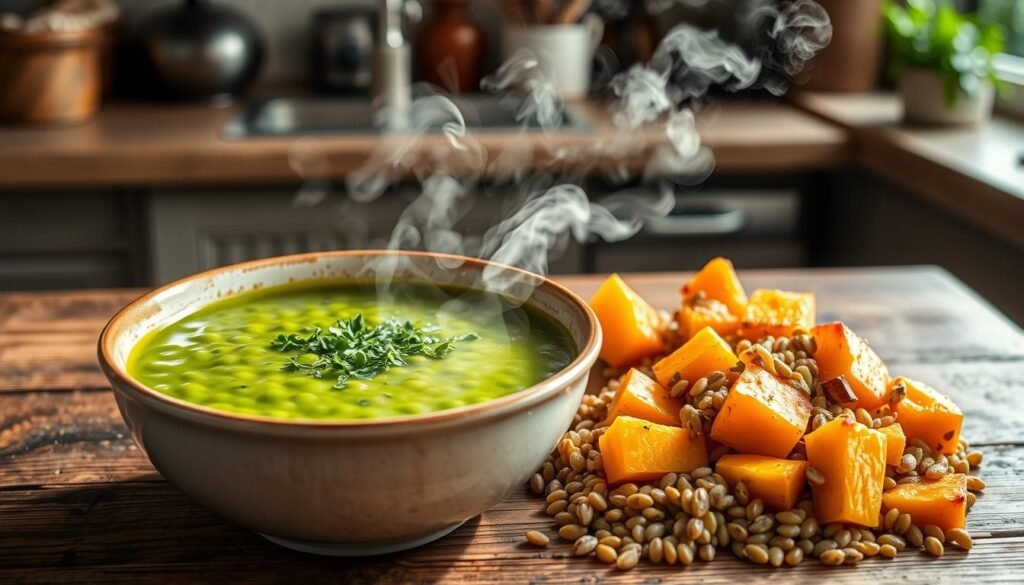
For fats, 3 tablespoons of extra virgin coconut oil enrich the soup, while 4 cups of vegetable broth provide a deliciously flavorful base. To finish, I include a can of full-fat coconut milk for extra creaminess. Adding 1 can of chickpeas and 8 ounces of baby spinach enhances the nutritious profile, making it a true soup with vegetables.
Optional Ingredients to Experiment With
The beauty of this homemade soup lies in its flexibility. To change up the texture or sweetness, try tossing in sweet potatoes or pumpkin. You can experiment with spices like thyme, cumin, and oregano to personalize the flavor profile. I also love using a blend of garam masala for a warm, complex layer of taste.
Feel free to adjust seasonings too. Typically, I season my soup with 2 teaspoons of kosher salt and cracked black pepper. For garnishes, incorporating flavors such as 3 tablespoons of olive oil, 1/4 teaspoon of turmeric, and 1/4 teaspoon of smoked paprika adds a little extra flair.
Lastly, this versatile vegan soup can be reheated either in the microwave or on the stovetop. Make sure to stir often and add extra broth or water if it becomes too thick. This homemade soup can also be meal-prepped and stored in the fridge for up to 5 days or frozen for up to 3 months. It’s a convenient and delicious way to include soup with vegetables and versatile vegan ingredients into your meal plan.
Preparing the Split Peas
Properly preparing split peas is crucial for optimal texture and digestibility. Whether you are new to vegan soup preparation or an experienced cook, understanding the best practices for preparing split peas ensures your soup turns out perfect every time.
How I Soak and Rinse the Split Peas
The key to a creamy and delightful soup involves soaking and rinsing the split peas. I always start by soaking the peas overnight. This not only reduces the cooking time but also helps to remove indigestible sugars that can cause gas. In the morning, I drain the water and rinse the peas thoroughly under cold water. This step is vital in preparing split peas for a smooth, hearty dish.
Tips for Perfectly Cooking Split Peas
Cooking split peas requires attention to detail. To achieve the best results, I recommend simmering the peas on low heat. A vigorous boil can cause the peas to break apart and become mushy, which is not ideal for our vegan soup preparation. Instead, a gentle simmer ensures they cook evenly, contributing to a thick, savory consistency.
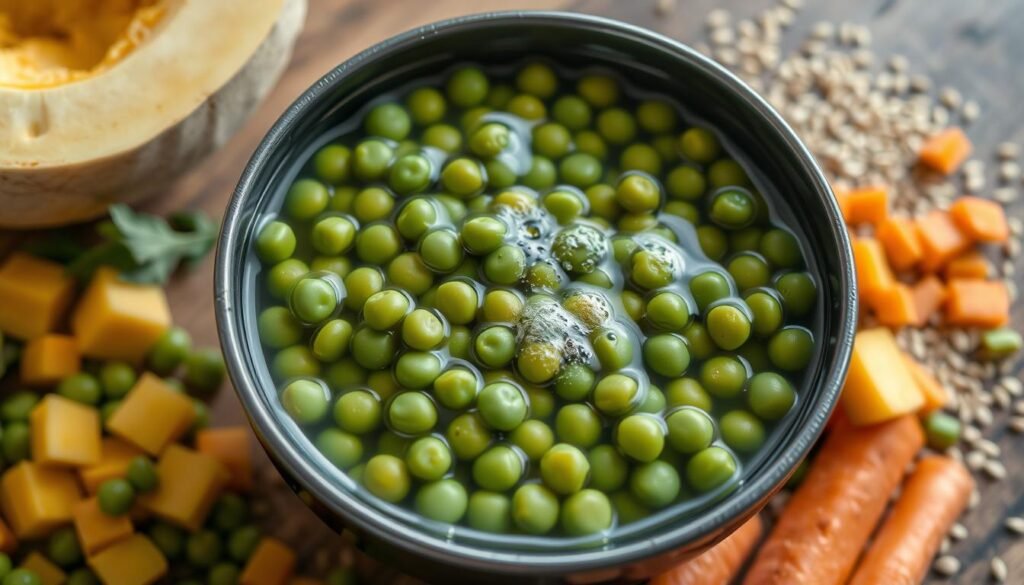
During the simmering process, frequently check the peas to ensure they maintain their structure. If you find that the water level is dropping too low, simply add more vegetable broth to keep the peas submerged. By following these tips, cooking split peas and integrating them into your recipe will become a seamless and enjoyable part of your kitchen routine.
Choosing the Right Barley
When it comes to making the perfect vegan split pea soup, selecting the right type of barley is crucial. The texture of the soup can be significantly influenced by your choice of barley, making it essential to choose wisely. I prefer using pearl barley because it has a quicker cooking time and yields a slightly softer texture than hulled barley, which tends to be chewier.
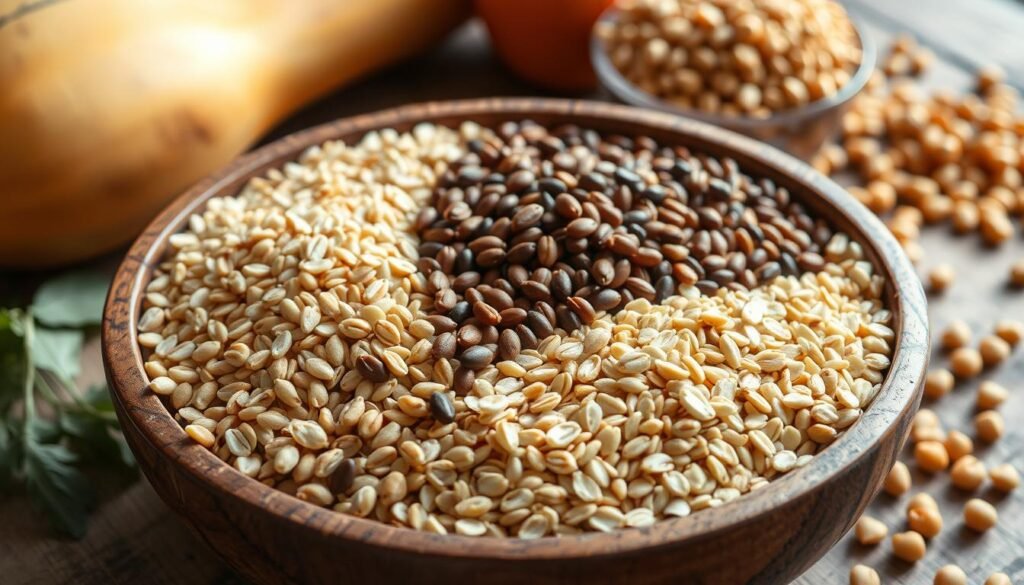
Types of Barley: What I Use
The two most common types of barley you’ll encounter are pearl barley and hulled barley. Pearl barley is processed to remove the outer bran layer, which reduces cooking time and gives it a softer texture. This makes it an excellent choice for vegan cooking, especially in soups. Hulled barley, while higher in fiber, takes longer to cook and provides a chewier bite. I find pearl barley ideal for this recipe as it balances both nutrition and convenience.
Nutritional Benefits of Barley
Incorporating barley into your vegan cooking offers numerous nutritional benefits. This nutritious barley is loaded with fiber, essential vitamins, and minerals. It supports digestive health and helps in lowering cholesterol. With 12.5 grams of protein per 100 grams of uncooked barley, it serves as an excellent plant-based protein source. This makes it a valuable addition to your vegan split pea soup, ensuring you’re not just making a flavorful meal but also a highly nutritious one.
Butternut Squash: A Key Ingredient
Incorporating butternut squash in soup brings a delightful sweetness and creamy texture that’s hard to resist. This versatile ingredient melds perfectly with the earthiness of split peas and barley, creating a harmonious balance in flavors. High in antioxidants like vitamins A, C, and E, the benefits of butternut squash are plentiful, making it a nutritious addition to any meal.

How to Prepare Butternut Squash
When it comes to preparing butternut squash, the process is straightforward yet crucial for enhancing the soup’s flavor profile. Begin by peeling the squash using a sturdy vegetable peeler. Once peeled, cut the squash lengthwise and scoop out the seeds with a spoon. Then, dice the flesh into bite-sized cubes. I usually bake the cubes at 400°F (205°C) for 50 to 60 minutes to bring out their natural sweetness and ensure they are tender enough to blend seamlessly in the soup.
Nutritional Perks of Butternut Squash
Butternut squash is not just about taste; it offers myriad health benefits. Rich in essential vitamins and minerals, it supports immune function and eye health thanks to its high vitamin A content. The benefits of butternut squash also include a good amount of dietary fiber, promoting healthy digestion. Moreover, its anti-inflammatory properties, owing to its antioxidant content, make it a powerhouse ingredient for boosting overall health.
Cooking the Soup Base
Creating a remarkable soup base is key to achieving a delicious, hearty vegan split pea soup with barley and butternut squash. The process of cooking vegan soup base begins with the aromatic foundation, a crucial step that infuses the soup with rich, complex layers of flavor that come together beautifully as it simmers.
How I Start with Aromatics
The secret to a satisfying soup lies in properly sautéing vegetables. I always start by sautéing diced onions, minced garlic, and finely chopped carrots in a generous splash of olive oil. This process allows their natural sugars to caramelize, enhancing the sweetness and depth of the soup base. To build complexity, I also include celery and bell peppers, stirring constantly to prevent burning while unlocking their flavors. Adding herbs like thyme and bay leaves at this stage helps to lay the groundwork for a fragrant, flavorful soup.
Layering Flavors for Deliciousness
Layering soup flavors is a step that shouldn’t be rushed. After the aromatics are perfectly sautéed, I add the split peas and allow them to absorb the fragrant base. Including vegetable broth, along with a touch of soy sauce or miso paste, adds umami, enriching the soup’s overall profile. Incorporating dried lima beans, barley, and diced tomatoes contributes additional textures and flavors, making each spoonful a delightful experience. To complement the butternut squash, I prefer a mix of spices including ground cumin, paprika, and a hint of smoked salt.
As the soup base comes together, you’ll notice a complexity emerging from the multi-layered flavors. Allowing the soup to gently simmer for about 2-3 hours ensures that each ingredient melds together seamlessly, creating a hearty, nutritious meal that’s perfect for any occasion.
Cooking Techniques
Understanding the precise cooking techniques can significantly elevate the flavors and textures of vegan dishes. In this section, I’ll delve into my favorite method for preparing a hearty vegan split pea soup and share insights on how to achieve the perfect soup consistency.
My Favorite Cooking Method
Among the various vegan cooking techniques, slow cooking vegan soup stands out to me. This method, which involves a steady simmer, ensures the ingredients meld seamlessly without losing their integrity. The consistent low heat helps maintain the nutrients and allows deeper flavors to develop throughout the broth. Here’s a brief overview of my go-to method:
- Prep Time: 5 minutes
- Cook Time: 35 minutes
- Total Time: 38 minutes
- Serving Size: 6 Servings
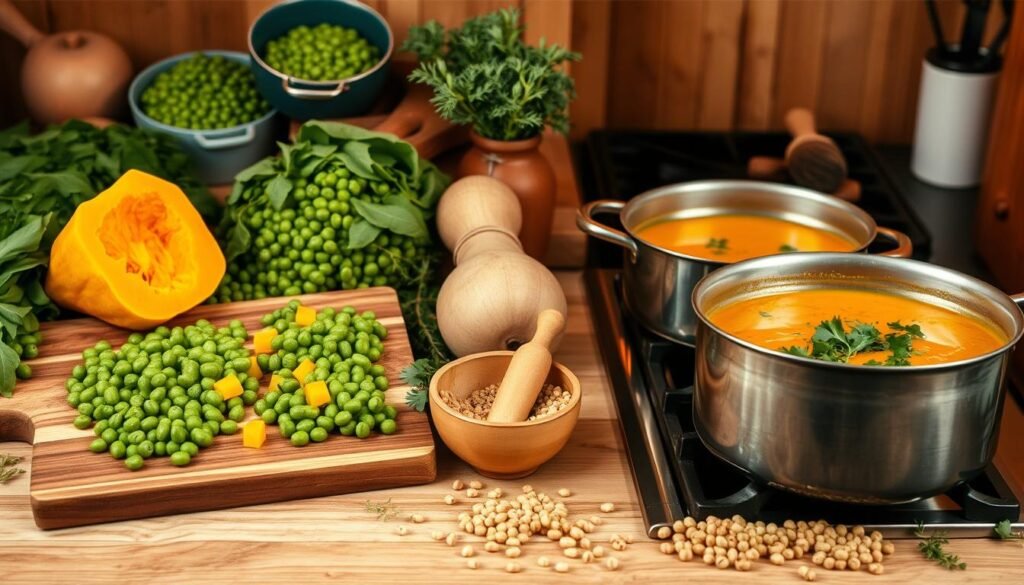
How to Ensure the Right Consistency
Achieving the ideal soup consistency is crucial for a delightful culinary experience. Here are a few tips to help you perfect it:
- Control Cooking Time: Extended cooking time allows for a thicker consistency, while a shorter period keeps it more broth-like.
- Adjust Broth Quantity: Modifying the amount of broth added can hugely impact the texture. For a thicker soup, reduce the broth, and for a thinner one, increase it accordingly.
- Use an Immersion Blender: Blending part of the soup can add a creamy element while keeping it chunkier. This is especially useful for those who enjoy a varied texture in their soups.
These simple but effective techniques ensure that you can tailor the soup consistency to your liking while harnessing the nutritious qualities of all the ingredients involved. Embrace slow cooking vegan soup for a wholesome and satisfying meal.
Simmering the Soup
Savoring a perfectly made Vegan Split Pea Soup requires careful attention to simmering. Gently simmering the soup for about 45-60 minutes is ideal for achieving the best flavor. This time frame allows the ingredients to break down and blend seamlessly, resulting in a rich and comforting dish.
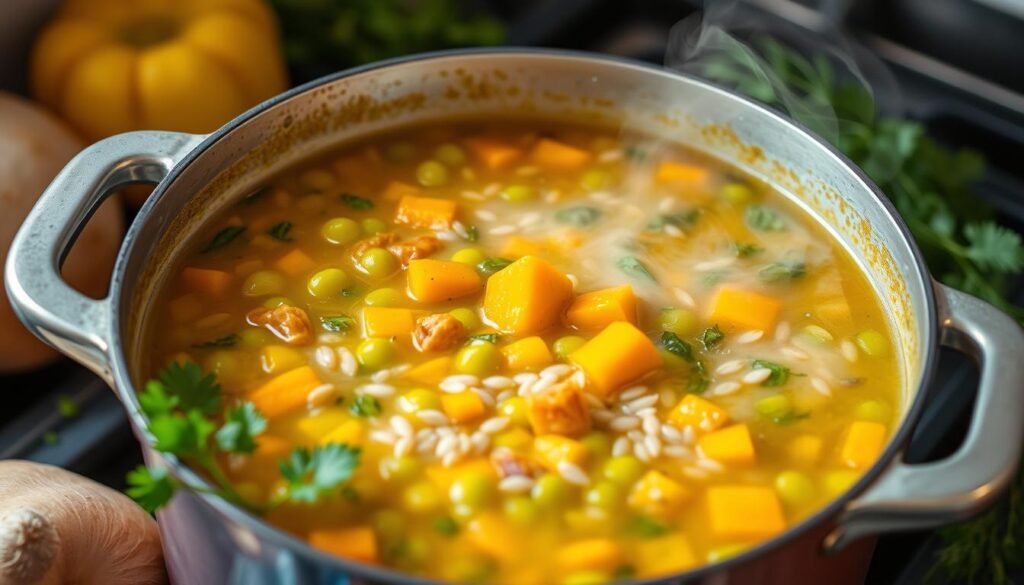
Ideal Cooking Time for Best Flavor
For the ultimate flavor, I make sure to give the soup ample time to simmer. Bob’s Red Mill® split peas, along with the butternut squash, onion, leek, garlic, and other assorted vegetables, truly benefit from this gentle cooking method. I have found that about 45 minutes of simmering after the broth begins to boil works wonders. It ensures the split peas cook through, and the vegetables soften perfectly, making every spoonful delectable.
How I Adjust Seasoning During Simmering
Seasoning adjustments are crucial for a well-balanced simmering vegan soup. Initially, I season the soup lightly with bay leaves, thyme, and rosemary. As it simmers, I periodically taste and make small seasoning adjustments. After around 40 minutes, when the ingredients have mingled well, I add final touches of salt and pepper. This method lets the flavors develop fully, enhancing the overall taste profile without overpowering any single ingredient.
Making It Creamy
Achieving a creamy vegan soup without using dairy can be a delightful challenge. One of my favorite techniques involves using ingredients that naturally break down during cooking, such as split peas. As they cook, split peas create a creamy base, ensuring that dairy-free creaminess is achieved effortlessly.
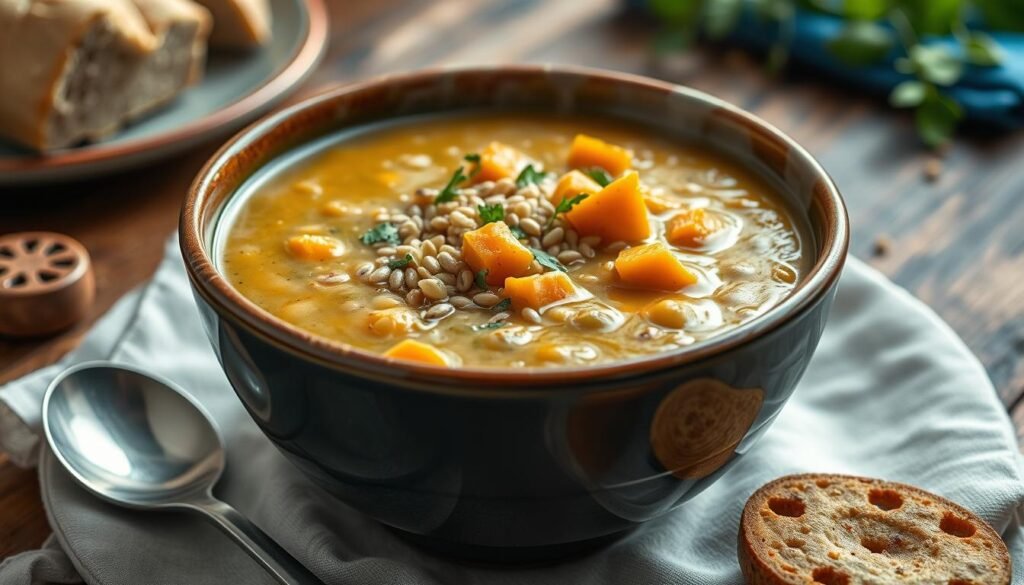
How I Enhance Creaminess Without Dairy
For an extra layer of richness, I like to blend part of the soup after it’s done cooking. A simple immersion blender does the trick, transforming chunks into a smooth, creamy vegan soup. Another fantastic option is incorporating plant-based creams. Coconut milk, for instance, adds a luxurious texture and is a superb way to introduce dairy-free creaminess without overpowering the other flavors.
Alternatives to Cream for Vegan Soups
While coconut milk is a popular choice, there are numerous vegan soup enhancements that can be just as effective. Options such as cashew cream or homemade almond milk can infuse a rich, velvety texture into the soup. Blending in some cooked potatoes or butternut squash can also thicken the soup naturally, offering both consistency and a nutritional boost.
Storing and Reheating
Storing vegan soup properly ensures freshness while making your meal prep with soup more convenient and efficient. After you’ve made this delicious Vegan Split Pea Soup with Barley and Butternut Squash, it’s essential to store it correctly for later consumption.

My Tips for Properly Storing Leftovers
First and foremost, always allow your soup to cool completely before storing it. Once cooled, transfer the soup into airtight containers. This step is crucial to prevent bacterial growth and maintain the soup’s original flavor. When properly stored, this vegan soup can last up to five days in the refrigerator. If you’re planning a longer storage period, freezing is an excellent option. The soup can be frozen for up to three months and still retain its delicious taste and nutritional value.
Best Methods for Reheating the Soup
When it comes to reheating tips, the stovetop method is my favorite. Simply warm the soup over low heat until it is heated through. If you find that the soup has thickened too much while stored, adding a bit of water or vegetable broth helps in restoring its original consistency. Alternatively, reheating in the microwave is convenient; use 30 to 60-second intervals for even heating. Follow these reheating tips to ensure that your soup tastes just as good as when it was freshly made.
Using correct storage and reheating methods enhances the longevity of your soup, making it an excellent option for meal prep with soup. Plus, with these easy steps, you can enjoy a warm, hearty bowl of Vegan Split Pea Soup with Barley and Butternut Squash any time you desire.
Serving Suggestions
This vegan split pea soup is a wholesome and tasty dish that’s perfect for both casual and formal gatherings. When it comes to vegan soup serving suggestions, there are several options to enhance flavor and presentation. Here’s how I love to serve this heartwarming soup.
Perfect Accompaniments for My Soup
One of my favorite soup accompaniments is a slice of (vegan) buttered sourdough toast. The crispy texture pairs excellently with the smooth, creamy consistency of the soup. For a more substantial meal, I sometimes add avocado slices on top of the toast for an extra layer of flavor and healthy fats. Additionally, a crisp green salad drizzled with a light vinaigrette complements the rich, savory taste of the split pea soup.
How I Present the Dish
Presenting vegan dishes beautifully can elevate the dining experience, even for the simplest recipes. I always serve this soup in pre-warmed bowls to keep it hot for longer. A garnish of fresh herbs like parsley or cilantro adds a burst of color and freshness. For an additional flavor boost, I drizzle a bit of olive oil on top or sprinkle some nutritional yeast for a cheesy undertone.
Looking for more tips on presenting vegan dishes? Check out my favorite vegan spaghetti with tomato basil sauce recipe, which offers fantastic ideas for both casual and formal settings. Whether you’re making a simple weeknight meal or hosting a dinner party, these tips will help you create a delightful visual and culinary experience.
Variations of the Recipe
One of the most exciting aspects of this Vegan Split Pea Soup with Barley and Butternut Squash Recipe is its versatility. This recipe is perfect for customizing vegan soups to suit your personal taste and dietary preferences. In this section, I’ll share some of my favorite ways to modify this soup using different vegetables, spices, and herbs.
How to Add Different Vegetables
When it comes to recipe variations, adding different vegetables can significantly enhance the nutritional value and flavor profile of the soup. I love incorporating leafy greens like kale or spinach towards the end of the cooking process. Zucchini is another excellent addition; it offers a beautiful, mild taste and extra color. Here are some vegetables you might consider:
- Kale or spinach for added nutrients and a vibrant green color
- Potatoes for extra heartiness
- Zucchini for a light, refreshing flavor
- Carrots rich in Vitamin A
- Bell peppers for a slight sweetness
Spices and Herbs for a Flavor Twist
Experimenting with different spices and herbs can drastically alter the flavor of your vegan soup, making each batch unique and exciting. I often find myself customizing vegan soups by using spices and herbs that complement the existing ingredients. Here are some of my favorite combinations:
- Smoked Paprika: Adds a delicious smoky depth
- Curry Powder: Transforms the soup into a warming, comforting dish
- Fresh Herbs: Parsley, thyme, and rosemary bring a fresh, aromatic touch
- Chili Flakes: For a bit of heat, perfect on colder days
- Ginger and Turmeric: Antioxidant-rich additions that add a new dimension to the flavor profile
Remember, the key to creating delicious recipe variations is to start with small amounts of new spices and herbs. This way, you can adjust to your taste preference gradually.
Nutritional Information
Understanding the nutritional content of vegan soup can be a game-changer for anyone looking to maintain a healthy lifestyle. This Vegan Split Pea Soup not only boasts rich flavors but also packs numerous health benefits, making it a perfect healthy soup recipe for anyone seeking diet-friendly vegan meals. Let’s delve into the detailed breakdown of its key nutritional values to highlight why this soup fits a healthy lifestyle.
Breakdown of Key Nutritional Values
One serving of this Vegan Split Pea Soup offers a comprehensive nutrient profile, essential for a balanced diet. Here are some critical figures:
- Calories: 152
- Total Fat: 7g
- Saturated Fat: 1g
- Trans Fat: 0g
- Unsaturated Fat: 6g
- Cholesterol: 0mg
- Sodium: 1119mg
- Carbohydrates: 18g
- Fiber: 5g
- Sugar: 4g
- Protein: 5g
Why This Recipe Fits a Healthy Lifestyle
This healthy soup recipe can be a beneficial addition to your meal plan thanks to its impressive nutritional content of vegan soup. With split peas, barley, and butternut squash as key ingredients, this soup is rich in essential nutrients:
- High Protein: Both split peas and barley are excellent plant-based protein sources, promoting muscle health and maintenance.
- Rich in Fiber: This soup’s high fiber content aids in digestion and provides a satisfying sense of fullness, making it a standout among diet-friendly vegan meals.
- Creaminess Without Dairy: The natural creaminess from split peas offers an indulgent texture without the need for dairy, perfect for vegans.
- Vitamin-Packed: Split peas are high in Vitamin A, thiamine, and Vitamin K, while carrots add a substantial amount of Vitamin A and other minerals beneficial for vision, immune function, and bone health.
Incorporating this soup into your meal prep couldn’t be easier. Its robust nutritional profile supports a balanced diet, helping you achieve your health goals without compromising on flavor.
Final Thoughts
As I wrap up my guide on making this easy vegan soup, I can’t help but encourage you to try this recipe. Whether you are a seasoned vegan or just beginning to explore trying new vegan recipes, this Vegan Split Pea Soup with Barley and Butternut Squash offers robust flavors and significant nutritional benefits. Not only is it an ideal way to incorporate more plant-based meals into your diet, but it also serves as an excellent meal prep with vegan dishes option.
Encouragement to Try This Recipe
This soup is perfect for anyone looking to experiment with delicious vegan dishes. The split peas, packed with eight grams of protein per half cup, provide a hearty and satisfying base. Plus, the short cooking time of 25-35 minutes makes it convenient for weeknights. You can truly enhance its flavor by using vegetable broth. For further insights and an updated version of this easy vegan soup, you can check the Split Pea Soup Recipe.
How I Incorporate It Into My Meal Prep
Now, let’s talk meal prep with vegan dishes. This soup stores exceptionally well in the fridge, maintaining its flavor and texture. I love prepping it in large batches because the soup tends to develop a deeper taste as it sits. During the week, I reheat portions effortlessly, making mealtime a breeze. If I want to switch things up, I occasionally mix in different vegetables or beans like chickpeas or pinto beans to keep my meals exciting.
With the nutritional benefits of split peas and barley, combined with the delicious taste of butternut squash, this vegan soup is a win-win. Give it a shot; you won’t be disappointed!
Call to Action
As we wrap up this culinary journey, I’d love to hear how you’ve embraced this Vegan Split Pea Soup with Barley and Butternut Squash recipe. Whether you’ve added your own twist or followed the recipe to a T, your stories and experiences enrich our shared passion for plant-based cooking. Engaging with vegan cooking and sharing cooking experiences are what make our community thrive. Feel free to share your modifications and results in the comments below or tag me on social media using #VeganSplitPeaSoup.
Share Your Experience with This Recipe!
Your feedback and adaptations not only foster our collective culinary creativity but also help fellow readers perfect their soup-making skills. Have you discovered any unique spices or ingredients that elevated your soup? Or perhaps you found a technique that brings out the flavors even more? Sharing your cooking experiences benefits us all, making each bowl of soup a bit richer and more delightful.
Invitation to Subscribe for More Healthy Recipes
To stay updated with the latest in vegan cooking, subscribe to our newsletter. By subscribing for vegan recipes, you ensure you won’t miss out on new, innovative, and healthful plant-based dishes that I regularly share. Let’s continue to explore, create, and enjoy the vibrant world of vegan cuisine together. Join us on this flavorful journey, and let’s make every meal a celebration of health and compassion.
